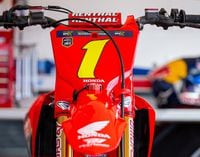With James Stewart absolutely killing his competition week in and week out aboard his KX125, one would think the KX125 would be the bike to beat. Bubba is on a full works bike, but it started off as a stocker. In past years' testing the KX125 has had some ups and downs. It does some things great and others just OK. For 2004 the Kawi got a few needed changes. Most notable is the new one-piece Uni-Trak linkage that attaches to a 20mm-longer swingarm. The KX also comes with a new 48mm Kayaba fork. The fork uses a new shorter front axle and aluminum axle collars.Kawasaki bikes have always been known for good handling, and '04 is no different; the KX125 handles like Magnum PI's Ferrari. We did encounter a few issues with the suspension. Although the KX125 uses a 48mm Kayaba fork, it is quite different from the Kayaba fork the YZ lineup uses. The fork on the KX125 seemed to be a tad on the harsh side in rough conditions. The fork works in the beginning of the stroke, but on hard hits it blows right through. The fork doesn't feel progressive enough. Lighter riders found themselves going out on clickers to soften up the first part of the stroke. It was hard to find a balance point. Overall, the fork has a harsh feel to it in stock trim. The shock worked well under braking, and stock settings weren't too far off. Under hard hits, the shock is a bit soft; going in on compression is a must. The handling is still good; the KX feels light and is very easy to throw around. Raising the seat 8mm did wonders for the ergonomics. It still feels a bit on the cramped side, but you don't feel as though you are sitting on a chopper anymore. A lower handlebar will level out your riding position; we opted to run the McGrath low bar. That setup seemed to work well for our shorter riders. Our taller rider went with a 909-team bend.Horsepower is important in the 125 class. The less power you have, the harder you have to work to get around the track. The KX125 isn't necessarily lightning fast, but it has solid, consistent power. Bottom-end power is a little hard to find; getting out of corners requires a lot of clutch. The motor really comes to life in the midrange, with power hitting smoothly and hard. The meat of the power is in the midrange. Top-end power is solid, but the motor doesn't like to be revved to the moon, and the power burns off early. Top-end also had a bit of a lean bog; we played around with jetting and were able to get rid of the bog, but we didn't gain any more top-end power. The transmission is smooth; shifting the bike is effortless and predictable. The stock gearing was in the ballpark and didn't need changing at any of the tracks.Depending on ability the KX125 has a group of riders it caters to. Slower beginners and novice-level riders will like the KX. Minus the lack of bottom-end, the motor is user-friendly. The handling is set up for the average novice. Intermediate and pro-level riders will have to do some work if they want to go fast for a long period of time. The motor requires some fine tuning, and the suspension will need adjustments. The light and nimble feel of the KX is what all manufacturers strive for. Overall our test staff liked the KX125, but all felt it has its weaknesses. The new graphics were liked by everyone, and riders were impressed they lasted through our test. The new KX125 is more durable than it ever has been, with stronger radiator side brackets and stronger engine-mount bolts. With a little love this bike can be a winner--just look at what Bubba and the boys on the Pro Circuit team do on it. Dial in the KX125 a tad, and you'll have a more than competitive bike.
Latest
/cloudfront-us-east-1.images.arcpublishing.com/octane/FUUS4XCVVZHYLBVJDLUGRT7RZQ.jpg)
/cloudfront-us-east-1.images.arcpublishing.com/octane/FSUTQ6NZ7RCO3M4NCBRJPKNM5M.jpg)
/cloudfront-us-east-1.images.arcpublishing.com/octane/XAZ2DGYTEJA2BE2TQ6H3KWXW4U.jpg)
/cloudfront-us-east-1.images.arcpublishing.com/octane/WC2HVBKSHNEJBODES2R5Y53VRY.jpg)
/cloudfront-us-east-1.images.arcpublishing.com/octane/JRSZS66MQBDH7O2JNMJHBQKIA4.jpg)
/cloudfront-us-east-1.images.arcpublishing.com/octane/WM3CKNM255E7NLISG3J5SOU63Y.jpg)
/cloudfront-us-east-1.images.arcpublishing.com/octane/XP5WDDR2AVGR3BF5S6TPCGYJ5A.jpg)
/cloudfront-us-east-1.images.arcpublishing.com/octane/7UAIG5GYLZH7LD72MKUYIHQYWU.jpg)
/cloudfront-us-east-1.images.arcpublishing.com/octane/6KXNSCIBK5BUNIJXUUELRO5W5Q.jpg)
/cloudfront-us-east-1.images.arcpublishing.com/octane/ZEQ7DSS7ZJCSLDAPECTSOAOGXI.jpg)
/cloudfront-us-east-1.images.arcpublishing.com/octane/OFSXJJ5PZFEZ5D5ZPMCFVHJUMA.jpg)
/cloudfront-us-east-1.images.arcpublishing.com/octane/N2JLNLG44VEKBMEPORRDTMX5A4.jpg)
/cloudfront-us-east-1.images.arcpublishing.com/octane/EOERU244ONEWVKQ7C24OHMRVWY.jpg)
/cloudfront-us-east-1.images.arcpublishing.com/octane/JF4T3ULTGNHTVEKSTNKLJ2IGKY.jpg)

/cloudfront-us-east-1.images.arcpublishing.com/octane/FAOZEEEXFVA3ZK2PYMY3DHI2EQ.jpg)
/cloudfront-us-east-1.images.arcpublishing.com/octane/WCAUGYKA5FDZTB64FM36LJFMMM.jpg)
/cloudfront-us-east-1.images.arcpublishing.com/octane/EIDVOIN5IJDMRIVS2VNTOOBVSA.jpg)
/cloudfront-us-east-1.images.arcpublishing.com/octane/5BSWCTPONFB3DJFRPJ34STZMR4.jpg)
/cloudfront-us-east-1.images.arcpublishing.com/octane/KSERUHQUTNHLBCWKXS2R3TYZHI.jpg)
/cloudfront-us-east-1.images.arcpublishing.com/octane/GGOH2AQRSVHY5C5JLNEVYLB5SU.jpg)
/cloudfront-us-east-1.images.arcpublishing.com/octane/TJJEHV3ATZFFXHUYZABHXKE2DI.jpg)
/cloudfront-us-east-1.images.arcpublishing.com/octane/M7L5LNQ5JZENHNBTCHEIKZKD24.jpg)
/cloudfront-us-east-1.images.arcpublishing.com/octane/WIC4RXQ36BAXNIW6U4UJ3XDLKI.jpg)